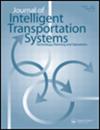考虑变道行为的高速公路交通车辆轨迹重构
IF 2.8
3区 工程技术
Q3 TRANSPORTATION
Journal of Intelligent Transportation Systems
Pub Date : 2025-05-04
DOI:10.1080/15472450.2024.2307031
引用次数: 0
摘要
车辆轨迹数据为许多交通应用提供了关键信息。由于数据收集技术的限制,通常只能获得部分轨迹。因此,通过观测数据推断缺失轨迹的轨迹重建对于许多下游应用来说是必不可少的一步。现有研究通常考虑网联车辆(CV)环境进行轨迹数据采集,而忽略了重建过程中的变道行为。联网和自动驾驶汽车(cav)的部署使得以更低的穿透率更有效地收集轨迹数据成为可能。在CAV环境下,提出了一种考虑LC机动的车辆轨迹重建算法。设计了Pettit检验和基于规则的优化算法来预测可能的LC时间点。然后应用两个车辆跟随模型重建轨迹。应用NGSIM US101数据集对不同CAV渗透率(例如2%、3%和5%)下提出的重建算法进行了评估。在CAV pr大于2%的情况下,LC时间点的预测精度较高,平均预测误差小于1 s。与地面真实轨迹相比,重建轨迹的平均绝对误差(MAE)在3%以下小于一个飞行器长度,CAV pr更高。本文章由计算机程序翻译,如有差异,请以英文原文为准。
Vehicle trajectory reconstruction for freeway traffic considering lane changing behaviors
Vehicle trajectory data provides critical information for many transportation applications. Due to limitations in the data collection techniques, usually, only partial trajectories can be obtained. As a result, trajectory reconstruction where the missing trajectories are inferenced by the observed data is an essential step for many downstream applications. Existing studies usually consider a connected vehicle (CV) environment for trajectory data collection and ignore the lane-changing (LC) behaviors in the reconstruction process. The deployment of connected and autonomous vehicles (CAVs) makes it possible to collect trajectory data more efficiently with much lower penetrations. This study proposes a vehicle trajectory reconstruction algorithm considering LC maneuvers in the CAV environment. The Pettit test and a rule-based optimization algorithm are designed to predict the possible LC time points. Then two car-following models are applied to reconstruct trajectories. The NGSIM US101 dataset is applied to evaluate the proposed reconstruction algorithm under varying CAV penetration rates (PRs) (e.g., 2%, 3%, 5%). The prediction of LC time points achieves high accuracy with average prediction errors less than 1 s under CAV PRs greater than 2%. Compared to the ground truth trajectories, the reconstructed trajectories have the mean absolute error (MAE) less than one vehicle length under 3% and higher CAV PRs.
求助全文
通过发布文献求助,成功后即可免费获取论文全文。
去求助
来源期刊
CiteScore
8.80
自引率
19.40%
发文量
51
审稿时长
15 months
期刊介绍:
The Journal of Intelligent Transportation Systems is devoted to scholarly research on the development, planning, management, operation and evaluation of intelligent transportation systems. Intelligent transportation systems are innovative solutions that address contemporary transportation problems. They are characterized by information, dynamic feedback and automation that allow people and goods to move efficiently. They encompass the full scope of information technologies used in transportation, including control, computation and communication, as well as the algorithms, databases, models and human interfaces. The emergence of these technologies as a new pathway for transportation is relatively new.
The Journal of Intelligent Transportation Systems is especially interested in research that leads to improved planning and operation of the transportation system through the application of new technologies. The journal is particularly interested in research that adds to the scientific understanding of the impacts that intelligent transportation systems can have on accessibility, congestion, pollution, safety, security, noise, and energy and resource consumption.
The journal is inter-disciplinary, and accepts work from fields of engineering, economics, planning, policy, business and management, as well as any other disciplines that contribute to the scientific understanding of intelligent transportation systems. The journal is also multi-modal, and accepts work on intelligent transportation for all forms of ground, air and water transportation. Example topics include the role of information systems in transportation, traffic flow and control, vehicle control, routing and scheduling, traveler response to dynamic information, planning for ITS innovations, evaluations of ITS field operational tests, ITS deployment experiences, automated highway systems, vehicle control systems, diffusion of ITS, and tools/software for analysis of ITS.

 求助内容:
求助内容: 应助结果提醒方式:
应助结果提醒方式:


